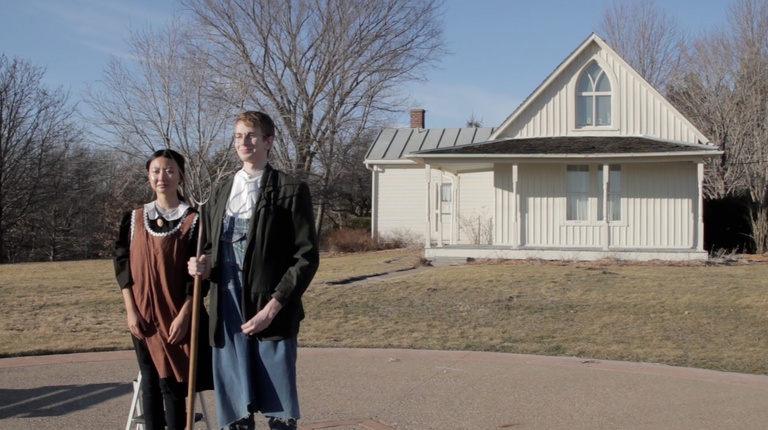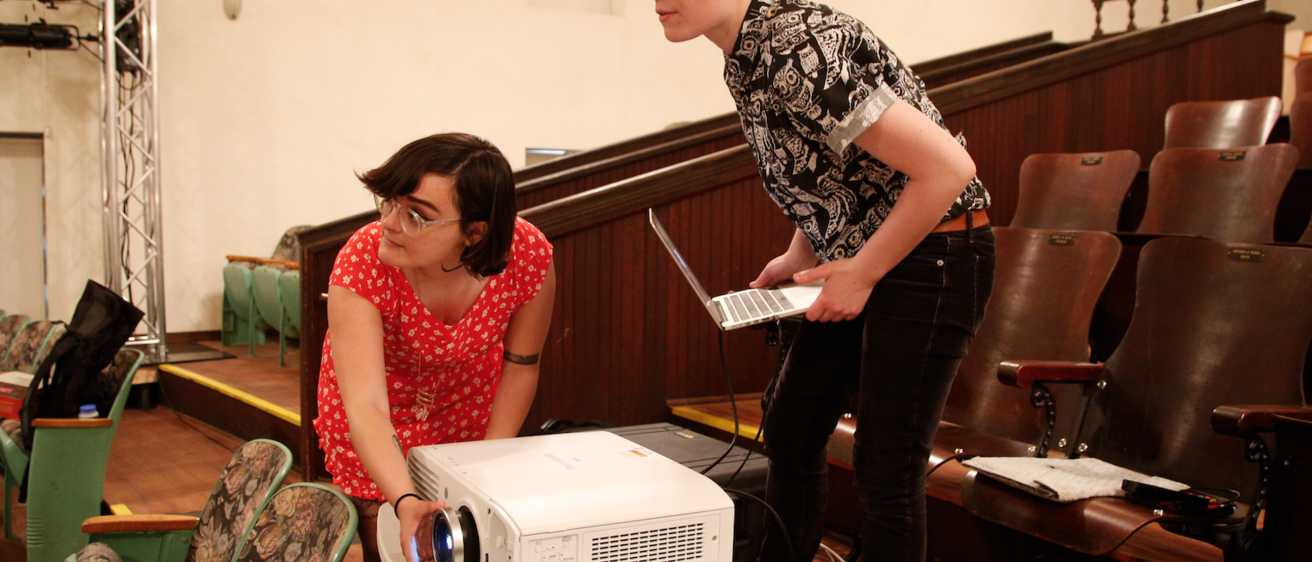Nonfiction filmmaking is inherently collaborative. Anna Swanson [pictured in black shirt working with a student] asked the students in her "Publicly Engaged Documentary" course both to question and commit to the partnerships that such filmmaking necessitates. Go beyond getting a project done or thinking toward job skills, she recommended; instead, consider being an artist-advocate or a scholar-social inquirer.
Swanson taught the course, which is an iteration of "Film/Video Production: Nonfiction (CINE: 2866)," in both fall and spring of last year, rolling in what she learned from her two passes through the Obermann Graduate Institute, first as a Fellow in 2015 and then as Senior Fellow in 2016. In addition to tasking students with thinking creatively and idiosyncratically about how nonfiction video/film can operate in the worlds from which it originates, Swanson added semester-long projects using video to do mutually-beneficial and tangible work with community partners.
Increasing Stakeholders
In the fall, students created films in collaboration with the 100Grannies, Iowa City Public Access Television, and United Action for Youth. In the spring, Swanson was able to place students with multiple projects via Pathfinders Resource Conservation and Development in Fairfield, Iowa, as part of the University's Office of Outreach and Engagement's RC&D partnerships. Topics of those films included the daunting task of mine reclamation in Iowa; local grass-fed beef initiatives; the Grant Wood legacy in connection to the American Gothic House Center in Eldon, Iowa; and the installation of a new public art piece (a tribute to the family farm) in Van Buren County.
"Having the opportunity to teach this course twice was invaluable," says Swanson, who is now living in Portland, OR after having completed an MFA in Film/Video Production from the Cinematic Arts Department and a Certification from Gender, Women's, and Sexuality Studies in May 2016. "I know it improved significantly from fall to spring. The support of the Office of Outreach and Engagement for the second semester was instrumental in making things go smoothly with transportation, previously established relationships, and institutional support for engaged teaching, but it also increased several-fold the number of stakeholders involved."
Collaborative Storytelling - Difficult but Worthwhile
Communicating the value of engagement and its open-ended nature, beyond job skills or services rendered, to both students and potential community partners, was one of the primary challenges that Swanson faced. "With video this is especially relevant," she reflects, "because as we move more and more into this digital moment, the skills and sensibilities that the students are developing are really sought after, but pedagogically it is so important to push the concepts that both students and community members have of what moving images can do, beyond the PSA/promo-piece model, towards collaborative storytelling, different kinds of documentation and their values, etc."
It was also important, though not always easy, to quickly build a strong class community and strong partner relationships. "In the fall, this was a huge challenge in teaching the class; so in the spring, I made sure to front-load the course with an introductory assignment where students made portraits of one another before taking those techniques out into the community," says Swanson.
A field trip to meet partners was also crucial. "With engaged teaching, leaving the classroom together to explore how your skills and perspective fit into the world is so important to get students excited about the possibilities of engagement, and ready to start building the relationships that are necessary to make it happen."
Student Gains Internship with Practical Farmers of Iowa

Some of those relationships have stuck. Freya Yu [pictured with a fellow student at the Grant Wood House], a senior in Cinematic Studies who is from Shanghai, China, is currently interning with Practical Farmers of Iowa. "After making a film about grass-fed beef," she says, "it was shown in several communities, and I was approached by Practical Farmers of Iowa to do an internship and make more films for and about farmers." She is currently making a series of films about small grain production (alternatives to corn or soybeans).
Having never been on a farm before, Yu is delighted to now be able to differentiate between dairy and beef cows, and to understand issues like crop rotation and soil conservation. She says that communicating clearly is one of the things she learned from Swanson, in addition to a host of technical and organizational skills. "You have to be really clear about what the partner needs," she says, noting that she usually checks and re-checks multiple times leading up to a shoot.
As she moves toward graduation, Yu would love to use her film skills to work with public partners to benefit their work. Swanson hopes to bring her public engagement knowledge to a college or university position in which she can reach more students like Yu.
